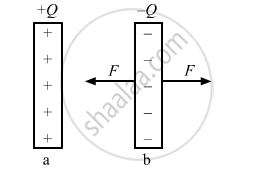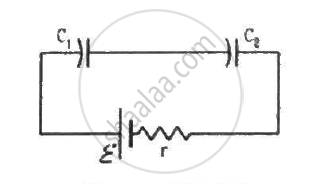Advertisements
Advertisements
Question
Obtain the expression for the energy stored per unit volume in a charged parallel plate capacitor.
Solution
Let us consider a parallel-plate capacitor of plate area A

Suppose the plates of the capacitor are almost touching each other and a charge Q is given to the capacitor. One of the plates, say a, is kept fixed and other say b, is slowly pulled away from plate a to increase the separation from zero to d. The attractive force on the plate b at any instant due to first plate is given by:
`F=Q^2/(2Aepsilon_0)`
The person pulling the plate b must apply an equal and opposite force (F) in the opposite direction if the plate is moved slowly.
Work done by the person during the displacement of the second plate:
W = Fd
`=(Q^2d)/(2Aepsilon_0)=Q^2/(2C)`
Here,`C=(Aepsilon_0)/d`, which is the capacitance of the capacitor in the final position.
The work done by the person must be equal to the increase in the energy of the system.
Thus, the capacitor has a stored energy.
`U=Q^2/(2C)`
Now, if we pull the plates of the capacitor apart, we have to do work against the electrostatic attraction between the plates. When we increase the separation between the plates from d1 to d2, an amount `Q^2/(2Aepsilon_0)(d_2-d_1)` of work is performed by us and this much energy goes into the capacitor. On the other hand, new electric field is created in a volume A(d2 - d1).
The energy stored per unit volume is thus given by:
`u=((Q^2(d_2-d_1))/(2Aepsilon_0))/(A(d_2-d_1))=Q^2/(2A^2epsilon_0)`
`1/2epsilon_0(Q/(Aepsilon_0))^2=1/2epsilon_0E^2`
Here, E is the intensity of the electric field.
APPEARS IN
RELATED QUESTIONS
A capacitor C1 of capacitance 1 μF and a capacitor C2 of capacitance 2 μF are separately charged by a common battery for a long time. The two capacitors are then separately discharged through equal resistors. Both the discharge circuits are connected at t = 0.
(a) The current in each of the two discharging circuits is zero at t = 0.
(b) The currents in the two discharging circuits at t = 0 are equal but not zero.
(c) The currents in the two discharging circuits at t = 0 are unequal.
(d) C1 loses 50% of its initial charge sooner than C2 loses 50% of its initial charge.
A 20 μF capacitor is joined to a battery of emf 6.0 V through a resistance of 100 Ω. Find the charge on the capacitor 2.0 ms after the connections are made.
A capacitor with stored energy 4⋅0 J is connected with an identical capacitor with no electric field in between. Find the total energy stored in the two capacitors.
A capacitor of capacitance 100 μF is connected across a battery of emf 6 V through a resistance of 20 kΩ for 4 s. The battery is then replaced by a thick wire. What will be the charge on the capacitor 4 s after the battery is disconnected?
Consider the situation shown in figure. The switch is closed at t = 0 when the capacitors are uncharged. Find the charge on the capacitor C1 as a function of time t.

A capacitor of capacitance C is given a charge Q. At t = 0, it is connected to an ideal battery of emf ε through a resistance R. Find the charge on the capacitor at time t.
A capacitor is charged by a battery and energy stored is 'U'. Now the battery is removed and the distance between plates is increased to four times. The energy stored becomes ______.
A 2µF capacitor is charge to 100 volt and then its plate are connected by a conducting wire. The heat produced is:-
What fraction of the energy drawn from the charging battery is stored in a capacitor?
A fully charged capacitor C with initial charge q0 is connected to a coil of self-inductance L at t = 0. The time at which the energy is stored equally between the electric and magnetic fields is ______.
